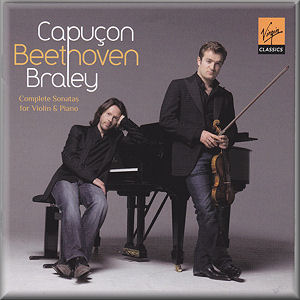|


alternatively
CD: MDT
AmazonUK
AmazonUS
|
Ludwig Van
BEETHOVEN (1770-1827)
The Complete Violin Sonatas
CD 1
Sonata No. 1 in D Major, Op. 12/1 (1797/98) [20:34]
Sonata No. 2 in A Major, Op. 12/2 (1797/98) [16:27]
Sonata No. 3 in E flat Major, Op. 12/3 (1797/98) [18:33]
Sonata No. 4 in A Minor, Op. 23, (1801) [16:15]
CD 2
Sonata No. 5 in F Major, Op. 24, ‘Spring’ (1801) [23:34]
Sonata No. 8 in G Major, Op. 30/3 (1803) [17:22]
Sonata No. 9 in A Major, Op. 47 ‘Kreutzer’ (1803) [36:56]
CD 3
Sonata No. 6 in A Major, Op. 30/1 (1803) [22:07]
Sonata No. 7 in C Minor, Op. 30/2 (1803) [24:33]
Sonata No. 10 in G Major, Op. 96 (1812) [27:13]
 Renaud Capušon (violin)
Renaud Capušon (violin)
Frank Braley (piano)
rec. 16-20 September, 10-13 October 2009, L’heure bleue, Salle de
musique, La Chaux de Fonds, Switzerland. DDD
 VIRGIN CLASSICS 6420010 [3 CDs: 71:44 + 77:45 + 73:47]
VIRGIN CLASSICS 6420010 [3 CDs: 71:44 + 77:45 + 73:47] 
|
Renaud Capušon and Frank Braley have been chamber music partners
going back some fourteen years. The present recording was made
in 2009 at L’heure bleue in the Salle de musique at La Chaux
de Fonds, Switzerland; a hall renowned for its marvellous acoustics.
The layout of the programme across the three discs has been
helpfully assembled in composition date order. Virgin Classics
packaged the set using a fold-out sleeve design incorporating
a booklet with a fine essay in English. Having handled the set
the design doesn’t seem especially durable.
To record the complete Beethoven violin sonatas must be a summit
in the recording career of any performer. Capušon explains,
“from the first opus 12 works to the last sonata opus 96,
we see a composer’s life pass before us.” There is great
assurance here. Giving the impression of live performances I
was struck by the relaxed freedom of these two artists as if
unencumbered by any predetermined decisions.
Dedicated to Antonio Salieri the opus 12 set of three violin
sonatas published in 1799 is a product of Beethoven’s late twenties.
From this set I especially enjoyed the light-hearted and witty
Sonata No .2. The vivacious playing of Capušon and Braley
in the opening Allegro vivace speaks of a remarkably
cheerful disposition. Serious and precise the Andante pi¨
tosto Allegretto has a contemplative quality. To conclude
the score the minuet-like Allegro piacevole - a Rondo
- conveys a sense of refinement with an infectious appeal.
From about the time that Beethoven was beginning to experience
disturbing signs of deafness comes the radiant and spirited
Sonata No. 5 known as the ‘Spring’. The opening
Allegro is constantly glowing, always poised and verging
on the witty. The feather-like and delicate slow movement has
the temperament of a lullaby. I loved the impish feel given
to the Scherzo while the Rondo: Finale has
high tension, being agitated and intense.
Composed in 1803 approximately between the Second and Third
Symphonies is the most famous of all the Beethoven sonatas,
the immense and majestic Sonata No. 9, Op. 47
known as the ‘Kreutzer’. Capušon and Braley’s performance
is as enjoyable as any I have heard. Playing of weight and energy
marks the mighty opening movement Adagio sostenuto. Here
the poetic passages are played with a real tenderness and the
Presto is impetuous and angry. There is a real refinement
to their interpretation of the Andante con Variazioni - most
attractive and gracious. I was struck by the conspicuous vigour
of the Presto: Finale that contains an unruliness
bordering on the feral.
The Sonata No. 10, Op. 96 comes from 1812, the year that
saw the completion of the Seventh and Eighth Symphonies. A favourite
score of mine this warm and congenial piece would be far better
known had it been allocated a name. With only occasional interruptions
of its intimacy the extended Allegro moderato is affectionate
and genial. The Adagio expressivo has a tempered quality
almost like a musical love letter. Short and bucolic the Scherzo
could be described as a fleet-footed dance. Whilst the high
spirited Finale, marked Poco Allegro, is
full of contrasting ideas and suffused with optimism. With a
final burst the concluding bars are rapid and vital.
Competition in the catalogues for recordings of the complete
Beethoven violin sonatas is intense. I have greatly enjoyed
these performances and rank them alongside my long time favourites.
I have always admired the spirited and robust performances from
Pinchas Zukerman and Daniel Barenboim. Made in 1971/73 in Berlin
and London I have these recordings as part of a nine disc box
set of Beethoven chamber music from EMI Classics 5 74447 2.
In addition I am also fond of the spontaneous feel to the exciting
readings from Gidon Kremer and Martha Argerich on Deutsche Grammophon
447 058-2. For their impeccable unity and directness there are
excellent performances from Itzhak Perlman and Vladimir Ashkenazy
on Decca 421 453-2. I hear favourable reports of the sets from
Wolfgang Schneiderhan and Carl Seemann on Deutsche Grammophon
Trio 477 550-2; Henryk Szeryng and Ingrid Haebler on Philips
Duo 446 521-2 (vol. 1) and 446 524-2 (vol. 2) and also from
Augustin Dumay and Maria JoŃo Pires on Deutsche Grammophon 471
495-2. A lesser known set that deserves praise is from Corey
Cerovsek and Paavali Jumppanen. These consistently satisfying
performances, marked by their selfless dedication, were recorded
in 2006 at La Chaux-de-Fonds in Switzerland on Claves CD 50-2610/12.
This set of the complete Beethoven violin sonatas does credit
to the artistry of Capušon and Braley. These performances just
grew and grew on me and can stand alongside the finest sets
available.
Michael Cookson
|

